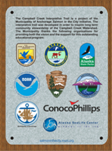Stormwater Display - 61° 9' 46" N, 149° 52' 35" W

■



|
 Visit the Trail Visit the Trail(Google Earth Required) |  Site Navigation |
 
|
 
|
|
Stormwater Display - 61° 9' 46" N, 149° 52' 35" W |
 ■ |
|||||


|
||||||
|
|
A Storm BrewingRoads, driveways, and roofs are part of the urban landscape. These hardened surfaces can have unfortunate impacts on our water quality and salmon.Altered LandscapeUrban development has transformed parts of Anchorage's landscape into roofs, streets, and other hardened surfaces, impacting water quality and quantity. Rain and snowmelt run off these hardened surfaces rather than soaking into the ground. Stormwater flows rapidly into storm drains and then into our creeks where it can result in flash flooding. This runoff also carries harmful pollutants into creeks. Curiously, hardened surfaces can also reduce the amount of water in our creeks. Paved surfaces prevent water from soaking into the soil and replenishing groundwater that creeks depend on to maintain flows during dry periods. Unnatural ImpactsFlooding, pollution, and prolonged low water levels are more than just an inconvenience for salmon in our creeks. Flash flooding erodes creek banks, filling the water with sediment that can smother salmon eggs. Lower water levels in summer may result in higher water temperatures that are harmful to young salmon. Polluted water affects the health of everything that lives in the creek, including salmon. Means to Clean WaterThe Municipality of Anchorage is working with the public to reduce problems associated with stormwater runoff. Some activities include the following:
|